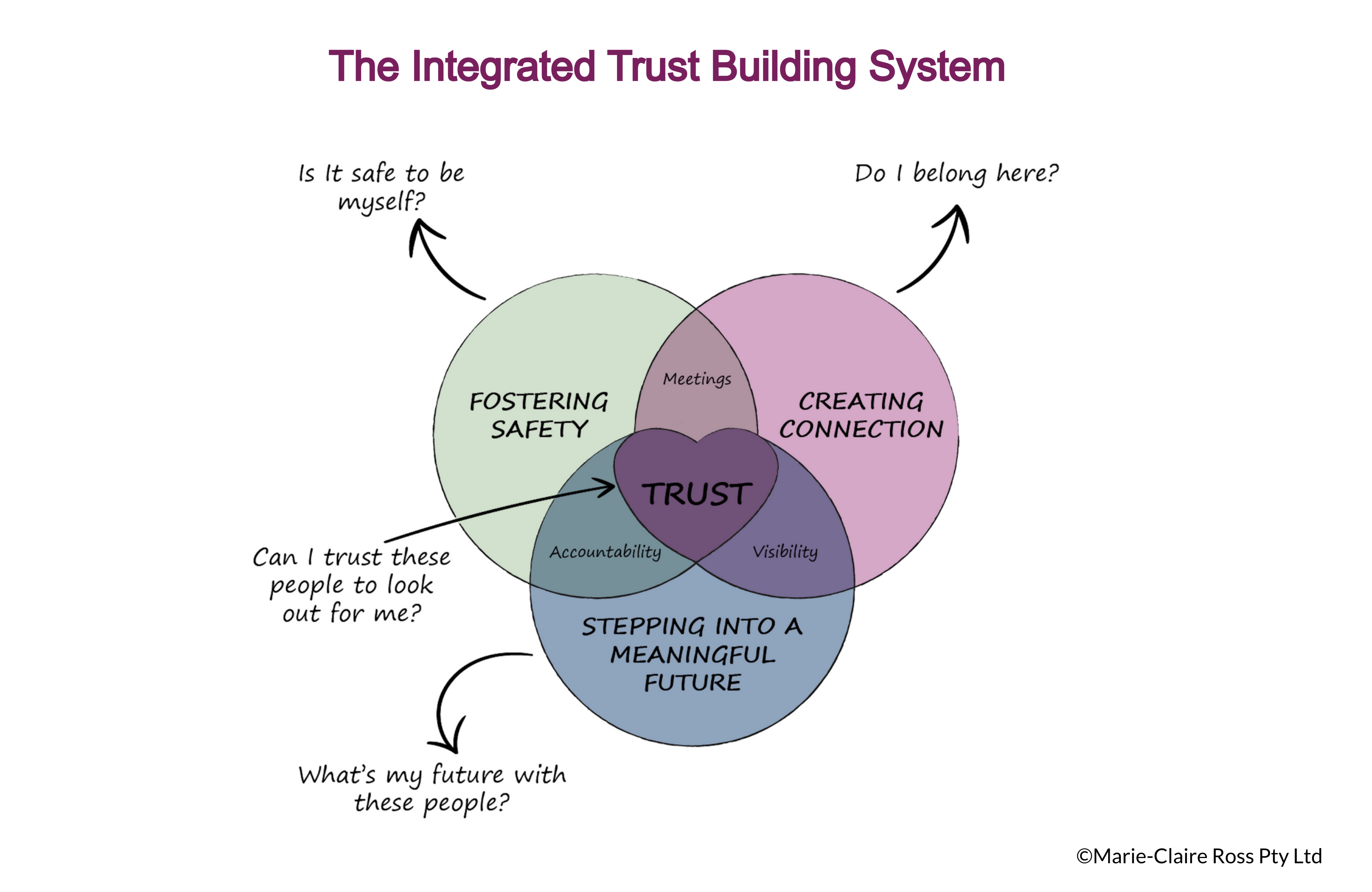
Trust in business is foundational. It underlies every human relationship, every interaction, every communication, every initiative, every work project, and any strategic...
We are at a critical inflection point in workplaces today.
More than two years into working from home, the transition to hybrid working is not going as well as we would like to admit. The return to work has been a struggle with employees resisting going back to the office and bringing their full capability to their jobs.
A new study by Allianz Insurance found that Australian employees are fed up with their jobs. A staggering 2 million are posed to leave their employer over the next year.
High levels of employee burnout, increasing workloads due to staff shortages, poor workplace relationships, a fear of speaking about flexible hours, slow organisational responsiveness and managers who just don't get it are major contributors to the staff exodus or what Allianz is calling the Workplace Wave.
The Workplace Wave is the next wave of change whereby the disruption of the pandemic is causing permanent shifts in desired ways of working, employee engagement and, in turn, workplace mental health.
As I mentioned last week, employee expectations have changed for good. Employee's priorities and values have shifted. People have left isolation with a new sense of self-awareness and self-worth. Employee well-being is now a priority. People want to work in a healthy company culture that has a positive employee experience.
Today, people weigh up how valued they feel in their jobs versus whether they are merely creating outcomes and value that benefit others, at the risk of their own personal fulfilment and health.
Kenneth Matos, the Director of People Science from Culture Amp says , “Employees want to reestablish the belief that what they're putting in is equal to what they're getting out. If they can't increase what they get, they're going to decrease what they put in.” These issues just aren't germaine to Australia. The recent Microsoft Global Work Trend study found similar themes. Employees are shaping a new kind of work environment to suit their individual needs.
Companies that fail to listen to the change in employee expectations risk high turnover rates, worker's compensation claims and ensuring employee retention in a tough market.
Central to improving the situation are employee centric workplaces that respect employees and provide them with the support and space to unlock their full potential and deliver transformative results. Workplaces that have leaders with the right capabilities to create a trusted, team culture. Leaders who are aware of the issues facing their employees and are more mindful in their leadership approach - customising to their direct report's individual needs. After all, we have five generations of employees with different work styles and different needs. A one-size-fits-all approach to leadership doesn't work.
This might seem overwhelming to any time-poor leader. Of course, without the right structure and systems to get this right, you will waste a lot of time. That's why I've created the Integrated Trust Building System that is explored in greater detail in my book, Trusted to Thrive: How leaders create connected and accountable teams. It helps leaders more easily strengthen interpersonal relationships in teams.
Let's dig into it with some tips on how you can be the leader that your employees want today.
Employees require leaders who reassure them that their emotional needs are being met through both verbal and non-verbal communication. With remote employees, this has become more critical because it's easy to miss non-verbal signals that we notice when we are face-to-face.
We process whether we can trust someone through our emotions. It is vital that leaders know how to communicate both verbally and non-verbally to the part of the brain that manages trust - the limbic brain. The part of the brain that doesn't understand language, but feelings.
According to neuroscience, there are three important practices (fostering safety, creating connection, stepping into a meaningful future) that leaders need to use in their daily communication, to emotionally engage employees, so the limbic system trusts the situation. These are underpinned by three important interactions - meetings/ one-on-ones visibility. To foster an environment of trust and safety in the hybrid workspace, you must be purposeful about:
Psychological safety involves creating a safe space where people can be themselves, but it's hard because our fear of interpersonal risk holds us back from fully contributing to the team for fear of retribution. With hybrid workplaces, it's very easy to hide from colleagues.
Leaders must:
1. Run meetings to increase safety. This requires having the awareness to know when you might be communicating, either verbally or non-verbally in a way that reduces safety (eg: dismissing people, ignoring remarks or criticising). It also requires having the skills to ensure every feels seen and heard by including everybody in the conversation (not just the loud talkers).
2. Ensure meetings help individual team members feel supported by you and one another through emotional check-ins that explore how people are feeling. This requires action taken if someone has hit a low point either through discussing privately after a meeting or with others in the team.
3. Conduct team calibrations through regular project updates, so people understand what each team member is doing and any issues can be sorted out quickly. This includes asking if people are stuck, so that the team can help out.
4. Have regular one-on-ones with employees to help prioritise work so people aren't overwhelmed with workloads. According to Microsoft's Work Trends Index Report , 81% of employees say it's important that their managers help them prioritise their workload, but less than a third (31%) say their managers have ever given clear guidance during one-on-ones.
5. Share clear expectations for timelines, goals and what good looks like, so employees aren't afraid of disappointing you. This also include regular employee feedback sessions (both positive and negative) to cultivate a sense of security and confidence, but to also hold employee's accountable for results.
6. Discuss how employees want their productivity measured. A Citrix Work 2035 study found that 86% of employees said they would prefer to work for a company that prioritises impact over activities. People want to be measured on the value they deliver, not the volume. Tracking hours worked or meetings attended isn't enough to show how hard someone is working. Co-create other measurements that show the impact achieved, rather than tasks done.
According to the Allianz study, nearly half (46%) of the employees surveyed feel no change in levels of isolation or connectedness to their colleagues, as they did during periods when lockdowns and other more extreme COVID-19 restrictions were in place.
A sense of belonging is important to our wellbeing and it requires leaders who know how to connect people together. Hybrid workplaces mean that we no longer have serendipitous hallway conversations. We are now finding a better way to build stronger relationships and understand one another with reduced in-person contact and less communication.
Creating connection in a workplace is a multi-faceted process. It's more than just connecting people together. It also involves explaining how all of the different parts fit together within the broader organisational landscape. The projects, products, platforms, priorities right through to all the people that make it happen.
As a leader you create connection, through helping people understand their personal impact, how others benefit from their work and all of the people and parts across an organisation and how they link together.
7. Schedule regular one-on-ones with each employee so they feel more connected. Understand that people are feeling isolated and even paranoid they are missing out on opportunities that others are getting in the workplace. Check-in with remote employees to ask if there are times when they feel excluded. Brainstorm solutions.
8. Create collisions. It's hard to replicate the random interactions people have in a workspace. Engineer serendipitous encounters by scheduling random meetings for your employees to connect with each other and those across teams. This could be video calls or a monthly lunch event with a rotating roster of employees from different teams, so that you build broader connections and reduce silos. Work on building strong coworker relationships in your team.
9. Be intentional about in-person events. Coming in to work must have value. People will come in to the office to be with their friends, reconnect, socialise or work on collaboration projects.
10. Be transparent and honest about what's going on to improve visibility. This includes sharing anything you learned in meetings, the rationale behind decisions and the context behind pretty much everything.
11. Discuss the meaning behind the work that individuals do and how it impacts others. Link personal objectives to broader business goals.
12. Encourage team members to share customer stories that have occurred recently. This helps people understand the impact of your team and company. Story-telling creates behavioural norms and shared understanding.
Trust is about the future and our ability to envision that we have one. As human beings, knowing that we have a future provides us with the fuel we need to keep going.
Employees look to their leaders to ensure there is a future for the company. They want to know that the right decisions are being made to navigate ahead, that their hard work will be worth it and that there are opportunities for employees.
According to Culture Amp, employees who feel they lack development are 2X more likely to leave a job in the next year.
In fact Microsofts' latest study found that employees consider opportunities to learn and grow as the #1 driver of great work culture, a jump from 2019 when it was ranked #9.
Here are some tips to help:
13. Regularly talk about the vision of the company in team meetings. Ask your employees what excites them about the vision, team values, organizational goals or any challenges they see about reaching them
14. Provide learning opportunities in your team meeting. Schedule in 10 minutes for you team members to share what they have learnt over the last week. It could be work or personal.
15. Undertake regular learning as a team. Discuss with your team what skills or capabilities they want to learn together. Bring in a trainer to help. An effective team culture can be created by learning together.
16. In one-on-ones regularly discuss your employee's learning goals, what they hope to achieve and their progress. Support them with learning opportunities.
17. Share progress updates including your own KPIs and encourage accountability by sharing what you are personally doing to improve.
Today, modern leaders are being called to lead differently than previously. Effective leaders who master the art of being more inclusive, respectful, clear in their communication and caring of their people are the ones who will be in demand to lead team performance.
Use these tips to help your employees improve their job satisfaction and create a healthy team culture. If you want more, grab a copy of Trusted to Thrive which has been written for team leaders who want to lead strong team cultures.

Trust in business is foundational. It underlies every human relationship, every interaction, every communication, every initiative, every work project, and any strategic...

As someone who speaks at leadership conferences to help leaders understand how to identify and maintain trust, I often get requested about what team building exercises...